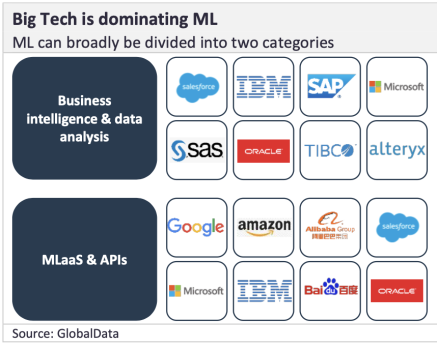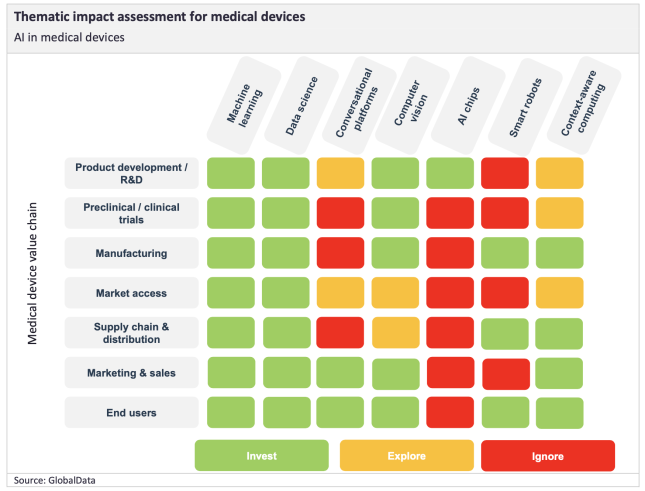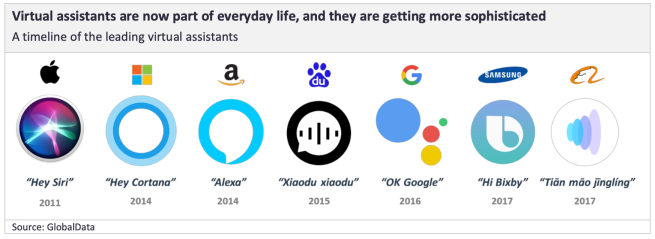
POSTED BY
Connor Lynes
The role of Artificial Intelligence in the future of healthcare
The use of AI in healthcare is expected to grow exponentially in the next five years. The applications of AI in healthcare are already many, with the potential to transform key aspects of the industry and drive innovation.
Artificial Intelligence is already influencing healthcare – with significant applications in everything from pharma and medical devices, to care provision, diagnosis and telehealth.
GlobalData forecasts that the market for AI platforms for the entire healthcare industry will reach $4.3bn by 2024, up from $1.5bnin 2019.
According to GlobalData’s Digital Transformation and Emerging Technology Survey2020, almost two-thirds of pharma professionals see AI as the leading disruptive technology in the next two years.
AI has been key to fighting the COVID 19 pandemic. COVID-19 has helped drive unprecedented digital transformation across the usually risk-averse healthcare industry with healthcare providers, pharma and medical device companies rapidly adjusting.
AI is now set to create significant opportunities. It will be a key driver of almost all future healthcare innovation - from diagnosis and screening to drug discovery and development. In this article, we take a closer look at some of the vital AI topics and how they will affect healthcare.
Machine Learning
Machine learning (ML), is where digital models are designed to learn and improve performance by gathering and analysing data themselves, without being explicitly told what to do.
Many organisations use ML as part of predictive data models or software platforms that analyse behavioural data. These solutions can automate and speed up development programmes.
ML is increasingly involved in data processing, where vast amounts of raw data can be transformed into useful, usable information. ML has the power to automate the entire process.
Established leaders with large customer bases, such as SAP, Salesforce, SAS, Oracle, and IBM, already hold strong positions in this segment. Most of the leading players offer cloud analytics, big data management, enterprise resource planning (ERP), and predictive analytics.
Data analytics companies have been a hot commodity in recent years, with Salesforce acquiring Tableau – a leader in analytics software – for $15.7bn in 2019.
ML systems can be costly to create in-house, especially as there is a skills shortage, so many organisations prefer to rent ML, and other AI services, from the cloud. This helps faster adoption and bypasses some of the cost of developing models. Big Tech such as Amazon, Microsoft, Google, and IBM are major players in this aspect of ML.

Virtual Assistants
Since Apple’s Siri on the iPhone 4S in 2011, virtual assistants have become somewhat ubiquitous.
Today, virtual assistants are available on devices such as smartphones, automated home products (including smart speakers), and wearables.
Amazon’s Alexa was boosted by its decision to open-source its platform, allowing developers to build and expand its capabilities. Alexa is now integrated into a broad range of non-Amazon products, including HP and Lenovo computers, Toyota cars, Ecobee thermostats, and many more.
The virtual assistant landscape can be divided into two groups: bot-building solutions for specific industries (such as Nuance in healthcare) and self-service providers offering suites of tools so organisations can build their own chatbots. IBM Watson was a pioneer in this field. However, Facebook – now rebranded as Meta – has recently purchased Wit.ai and Google has taken over API.ai (now Dialogflow).
Robotics
The field of robotics is not technically a subset of AI as most robots are not ‘smart’. Although most robots can mimic human actions, they do not learn from one repetition to another.
Advances in AI in robotics have resulted the growth of AI-enabled or smart robots. In healthcare, these smart robots can broadly be divided into three categories: cloud robotics, collaborative robots (or co-bots) and care robots.
Leaders in cloud robotics combine AI capabilities with substantial infrastructure - namely Amazon, IBM, Google, and Microsoft.
The robotics as a service (RaaS) market includes products that integrate cloud-based management and analytics services with physical robots.
Although much in robotics will be done from the cloud, edge computing is increasingly allowing these tasks to be performed on the robot itself.
Falling costs and improved functionality have facilitated a rapid increase in the demand for co-bots. Even SMEs are deploying co-bots for warehouse applications and pick-and-place tasks. Some of the leading co-bot manufacturers include Teradyne’s Universal Robots, and Robotiq, but the big industrial robot makers –ABB, Fanuc, and Yaskawa –have all launched co-bot products.
AI technologies – especially ML - are integral to the development of co-bots and other smart industrial robots.
The next big step will be to take this industrial automation and add other emerging AI technologies such as language-based learning and contextual awareness.
Care robots already provide care and support to the elderly, disabled, and unwell, but are a long way from mass adoption. Toyota and Honda have been developing human support robots for many years, while Intuition Robotics is beta testing its ElliQ social companion robot. ElliQ is a table-top device that uses ML and CV to provide information, conduct conversations, and play music. Belgian start-up Zora Robotics is developing eldercare services via customized Alexa-enabled Echo devices.
The impact of AI on medical tech
ML and data science will impact the development of new drugs and procedures, assisting in the collating, management and assessment of ever-growing big data. It will also feature in digital analysis and diagnosis, in scanning and screening, replacing routine visual procedures, improving accuracy and removing human error. ML and data science tools have the potential to reduce the time and expense of discovering new drugs, improve the chances of a drug’s approval, speed up clinical trials, and play a part in automated manufacturing and R&D.
The use of virtual assistants, chat-bots and other user interfaces will grow, as will its acceptance among patients and service users. For instance, Nina, launched by Sanofi, is being used to support patients with mild sleep disorders.
Babylon Health, a healthcare service provider, uses AI-driven chatbots to review a patient’s symptoms and then recommends diagnostic advice.
AI can assist with treatment decisions by analysing patient data, recommending treatment or assisting with diagnosis and screening, thereby reducing physician workload.
Routine image analysis and screening will rely more on AI.
Surgical robots deployed for minimally invasive procedures can reduce human error. AI-driven smart robotic devices will increasingly assist in complex procedures in surgeries and other interventions.
Care robots will become a more familiar part of social care in both care establishments and the home. AI-empowered robots such as hospital and care robots reduce the burden of patient care and mundane tasks.
In conclusion
ML and data science are the two most important subsets of AI, and the healthcare industry must invest in these technologies across all parts of the sector.
AI will continue to help manage the huge amounts of data in areas such as drug development and refinement. Importantly, AI must expand its role to care for, motivate, inform and interact with patients. Investing in AI-driven conversational platforms for end-users, care-bots in social care settings, and automated smart triage systems can help at every stage from symptom assessment, patient triage to wellbeing and improving patient outcomes.

Posted by Connor Lynes, Senior Consultant - MedTech
https://www.linkedin.com/in/connor-lynes
[All Information Sourced for Global Data]




